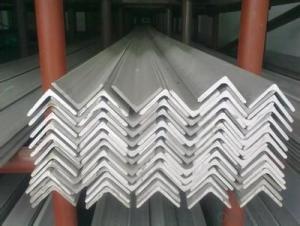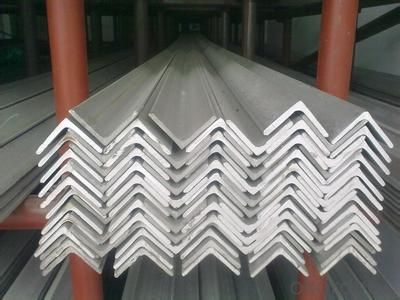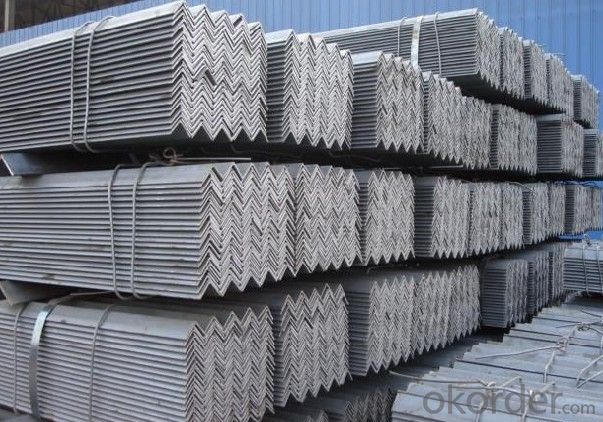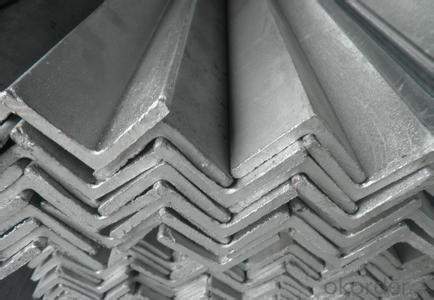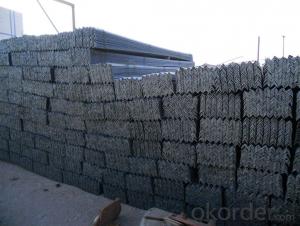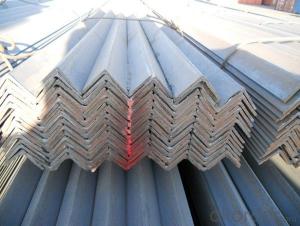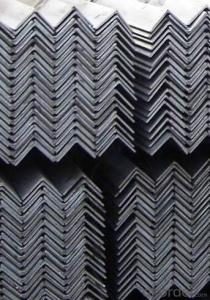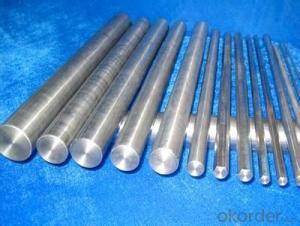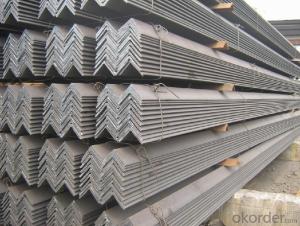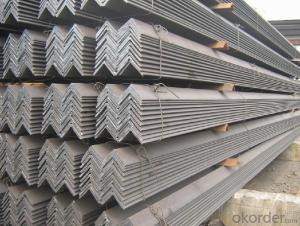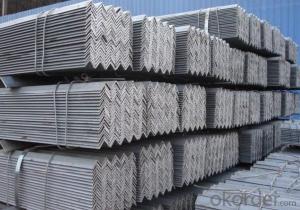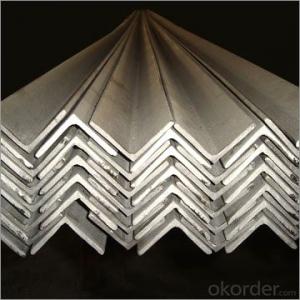Angle Steel Hot Rolled 20-250MM GB Q235 or ASTM
- Loading Port:
- Tianjin
- Payment Terms:
- TT OR LC
- Min Order Qty:
- 25 m.t.
- Supply Capability:
- 20000000 m.t./month
OKorder Service Pledge
OKorder Financial Service
You Might Also Like
Product Description:
OKorder is offering high quality Angle Steel Hot Rolled 20-250MM GB Q235 or ASTM at great prices with worldwide shipping. Our supplier is a world-class manufacturer of steel, with our products utilized the world over. OKorder annually supplies products to European, North American and Asian markets. We provide quotations within 24 hours of receiving an inquiry and guarantee competitive prices.
Product Applications:
According to the needs of different structures, Angle can compose to different force support component, and also can be the connections between components. It is widely used in various building structures and engineering structures such as roof beams, bridges, transmission towers, hoisting machinery and transport machinery, ships, industrial furnaces, reaction tower, container frame and warehouse etc
Product Advantages:
OKorder's Angle Steel Hot Rolled 20-250MM GB Q235 or ASTM are durable, strong, and resist corrosion.
Main Product Features:
· Premium quality
· Prompt delivery & seaworthy packing (30 days after receiving deposit)
· Corrosion resistance
· Can be recycled and reused
· Mill test certification
· Professional Service
· Competitive pricing
Product Specifications:
Manufacture: Hot rolled
Grade: Q195 – 235
Certificates: ISO, SGS, BV, CIQ
Length: 6m – 12m, as per customer request
Packaging: Export packing, nude packing, bundled
Sizes: 25mm-250mm、 | ||||||||||
a*t | ||||||||||
25*2.5-4.0 | 70*6.0-9.0 | 130*9.0-15 | ||||||||
30*2.5-6.6 | 75*6.0-9.0 | 140*10-14 | ||||||||
36*3.0-5.0 | 80*5.0-10 | 150*10-20 | ||||||||
38*2.3-6.0 | 90*7.0-10 | 160*10-16 | ||||||||
40*3.0-5.0 | 100*6.0-12 | 175*12-15 | ||||||||
45*4.0-6.0 | 110*8.0-10 | 180*12-18 | ||||||||
50*4.0-6.0 | 120*6.0-15 | 200*14-25 | ||||||||
60*4.0-8.0 | 125*8.0-14 | 250*25 | ||||||||
FAQ:
Q1: How do we guarantee the quality of our products?
A1: We have established an advanced quality management system which conducts strict quality tests at every step, from raw materials to the final product. At the same time, we provide extensive follow-up service assurances as required.
Q2: How soon can we receive the product after purchase?
A2: Within three days of placing an order, we will begin production. The specific shipping date is dependent upon international and government factors, but is typically 7 to 10 workdays.
Q3: What makes stainless steel stainless?
A3: Stainless steel must contain at least 10.5 % chromium. It is this element that reacts with the oxygen in the air to form a complex chrome-oxide surface layer that is invisible but strong enough to prevent further oxygen from "staining" (rusting) the surface. Higher levels of chromium and the addition of other alloying elements such as nickel and molybdenum enhance this surface layer and improve the corrosion resistance of the stainless material.

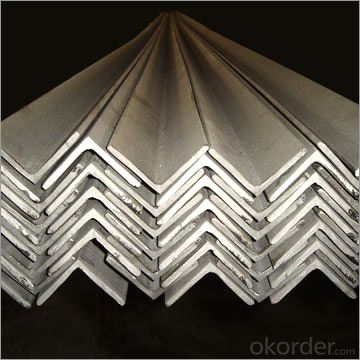
- Q: Bearing capacity of angle steel and channel steel
- Channel steel is a strip of steel with a cross section. Section steel with groove shape.Channel steel is a kind of carbon structural steel used for construction and machinery. It is a complex section steel. Its cross section has a groove shape. Channel steel is mainly used in building structure, curtain wall engineering, mechanical equipment and vehicle manufacturing, etc.. In use, it requires better welding, riveting performance and comprehensive mechanical properties. The raw material steel billet for channel steel is carbon or low alloy steel billets with a carbon content of not more than 0.25%. The finished channel steel is delivered by hot forming, normalizing or hot rolling. The specifications are expressed in millimeters of height (H) * leg width (b) * waist thickness (d), such as 100*48*5.3, which means waist height is 100 mm, leg width is 48 mm, waist thickness is 5.3 mm channel, or 10# channel steel. The same height of the channel, if there are several different leg width and waist thickness, also need to add a, B, C on the right side of the model to distinguish, such as 25#a, 25#b, 25#c and so on.Channel steel is divided into ordinary channel steel and light channel steel. Standard Specification for hot-rolled plain channel steel is 5-40#. Specifications for hot rolled flexible channel steel supplied by supply and demand agreement are 6.5-30#. Channel steel is mainly used for building structures, vehicle manufacturing, other industrial structures and fixed plates, cabinets, etc., and channel steel is often used in conjunction with i-beam.
- Q: How do you prevent steel angles from sagging?
- To prevent steel angles from sagging, there are several measures that can be taken: 1. Proper design: Ensure that the steel angles are designed and sized correctly for the load they will bear. This involves considering the span length, the applied load, and the material strength. Consulting with a structural engineer can help determine the appropriate size and thickness of the steel angles. 2. Adequate support: Provide sufficient support for the steel angles at regular intervals along their length. This can be achieved by using intermediate supports such as columns, beams, or braces. The spacing of these supports should be determined based on the load and the properties of the steel angles. 3. Reinforcement: Depending on the load requirements, additional reinforcements can be added to the steel angles. This can include stiffeners, gussets, or flanges to increase their load-carrying capacity and resistance to sagging. 4. Quality fabrication: Ensure that the steel angles are fabricated to meet industry standards and specifications. This includes proper welding techniques, accurate cutting, and appropriate surface preparation to avoid any weak points or defects that may contribute to sagging. 5. Regular inspection and maintenance: Regularly inspect the steel angles to identify any signs of sagging or structural issues. This can involve visual inspections, measurements, and non-destructive testing methods. Promptly address any identified problems to prevent further deformation and ensure the long-term integrity of the steel angles. By following these preventive measures, steel angles can be effectively protected against sagging and maintain their structural stability over time.
- Q: How do steel angles contribute to the overall safety of a building?
- Steel angles contribute to the overall safety of a building by providing structural support and reinforcement. They are commonly used in construction to connect and strengthen various structural components, such as beams, columns, and trusses. Steel angles help distribute loads and resist forces, such as wind, earthquakes, and heavy loads, thereby enhancing the building's stability and resistance to collapse. Additionally, they can prevent lateral movement and deformation, ensuring the structural integrity of the building.
- Q: Are steel angles suitable for earthquake-resistant construction?
- Indeed, earthquake-resistant construction can make use of steel angles. Steel, known for its strength and ductility, is an ideal material for withstanding seismic forces. Specifically, steel angles are commonly employed in seismic design and construction because of their ability to offer structural stability. Bracing elements in buildings often consist of steel angles, which help withstand lateral forces resulting from earthquakes. These angles can be installed diagonally between structural members, creating a rigid frame capable of effectively absorbing and dissipating seismic energy. By distributing the forces generated during an earthquake, these angles play a crucial role in preventing structural collapse. Moreover, steel angles can be designed and fabricated to meet specific seismic design criteria. Engineers can consider factors such as the building's location, expected seismic activity, and desired level of earthquake resistance. By utilizing advanced computer-aided design and analysis tools, engineers can optimize the placement and size of steel angles, thereby enhancing the structure's overall seismic performance. Apart from their strength and ductility, steel angles offer other advantages for earthquake-resistant construction. They are lightweight, reducing the overall weight of the structure and enabling more efficient seismic design. Additionally, steel is a recyclable material, making it a sustainable choice for construction projects. However, it is important to note that the suitability of steel angles for earthquake-resistant construction relies on various factors, including the specific design, construction techniques, and adherence to building codes and regulations. Professional engineering expertise and thorough analysis are essential to ensure the appropriate utilization of steel angles in seismic design. In conclusion, steel angles are suitable for earthquake-resistant construction due to their strength, ductility, and ability to provide structural stability. When appropriately designed and installed, they can effectively resist seismic forces and contribute to the overall safety and resilience of the structure.
- Q: How does the weight of a steel angle affect its load-bearing capacity?
- The weight of a steel angle directly affects its load-bearing capacity. In general, a heavier steel angle has a higher load-bearing capacity compared to a lighter one. This is because the weight of the angle contributes to its overall strength and stability. When a load is applied to a steel angle, it creates both compressive and tensile forces within the material. The weight of the angle helps to distribute these forces evenly, minimizing the risk of deformation or failure. Additionally, a heavier steel angle typically indicates a higher density and a greater amount of material used in its construction. This means that the angle can withstand larger loads without undergoing significant deflection or structural damage. It is important to note that the load-bearing capacity of a steel angle is also influenced by other factors such as its dimensions, material properties, and the type of connection used. However, the weight of the angle remains a crucial consideration in determining its overall strength and ability to support loads.
- Q: What are the different finishes available for steel angles?
- There are several different finishes available for steel angles, including hot-dip galvanized, mill finish, painted, and powder coated.
- Q: Can steel angles be used as lintels or supports for openings?
- Yes, steel angles can be used as lintels or supports for openings. Steel angles are commonly used in construction to distribute the load from above openings such as windows and doors, providing structural support and stability. They are strong, durable, and can be easily customized to fit the required dimensions, making them a suitable choice for lintels or supports in various construction projects.
- Q: What is the cost of steel angles compared to other structural materials?
- Various factors, such as market conditions, availability, and specific requirements, can cause the cost of steel angles to vary in comparison to other structural materials. However, as a rule, steel angles are often seen as a cost-effective choice for structural applications. When compared to materials like concrete or timber, steel angles are generally considered more affordable due to their relatively low production costs. Steel is readily available, and advancements in production techniques have resulted in competitive pricing. Furthermore, steel angles offer an exceptional strength-to-weight ratio, enabling lighter and more cost-efficient structural designs. Compared to other metals like aluminum or stainless steel, steel angles are typically more cost-effective. While aluminum and stainless steel may have certain advantages in terms of corrosion resistance or aesthetic appeal, their production processes and material properties tend to make them more expensive. It is worth noting that the exact cost of steel angles can vary depending on specific dimensions, quality, and quantity requirements. Prices may also fluctuate due to market conditions, such as changes in raw material costs or global supply and demand dynamics. Therefore, it is advisable to consult suppliers or industry professionals for accurate and up-to-date pricing information for steel angles.
- Q: How do you install steel angles?
- To install steel angles, first, identify the location and purpose of the angles. Measure and mark the desired positions on the surface where they will be installed. Use a level to ensure they are straight. Then, drill pilot holes at the marked positions. Align the angles with the pilot holes and secure them in place using appropriate screws or bolts. Finally, double-check the alignment and tighten the screws/bolts to ensure a secure installation.
- Q: Can steel angles be used for fencing and gate construction?
- Indeed, fencing and gate construction can make use of steel angles. The strength and durability of steel angles make them a prevalent choice in construction endeavors. They furnish robust frameworks for fencing and gate structures, delivering support and stability. The process of welding or bolting steel angles together is a simple means of achieving the desired shape and size for fencing and gate construction. Moreover, steel angles possess exceptional resistance to corrosion, rendering them suitable for outdoor applications. In summary, steel angles present themselves as a versatile and dependable option for fencing and gate construction.
Send your message to us
Angle Steel Hot Rolled 20-250MM GB Q235 or ASTM
- Loading Port:
- Tianjin
- Payment Terms:
- TT OR LC
- Min Order Qty:
- 25 m.t.
- Supply Capability:
- 20000000 m.t./month
OKorder Service Pledge
OKorder Financial Service
Similar products
Hot products
Hot Searches
Related keywords
